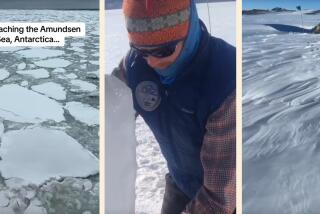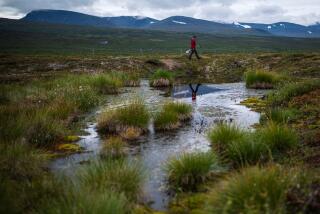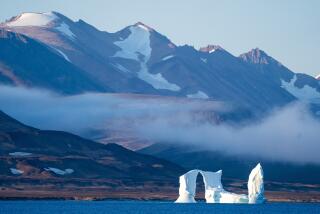Melting Releases Riddles on Global Warming
McMURDO, Antarctica — When Douglas MacAyeal jumped out of a helicopter onto Iceberg B15A, he landed squarely on a central mystery of global warming and climate change.
Wedged against Ross Island near McMurdo Station, the main National Science Foundation base in Antarctica, the berg is a leviathan of ice. As large as the state of Rhode Island, it contains enough frozen fresh water to supply the United States for three years.
At the same time, B15A may be the smallest jigsaw piece of a global puzzle. The ice sheets of the world’s remotest reaches are central to a renewed political debate over global warming and the carbon dioxide emissions widely considered responsible for it.
At every end of the Earth, the ice is slowly stirring.
Major ice formations in Antarctica and the Arctic are thinning or breaking up. In the alpine highlands of Europe and the tropical ranges of South America and Africa, mountain glaciers are in full retreat.
From the snows of Kilimanjaro in Tanzania to the Quelccaya icecap of the Andes Mountains in Peru, scientists see a world of ice in motion--shrinking, flexing, creeping unpredictably, almost like a living thing.
At a time when any scientific uncertainty about changing climate is politically charged, researchers are straining to understand the behavior of the ice sheets that cover one-tenth of the world and contain three-quarters of the world’s fresh water. The more they learn, the more complicated it all seems to be.
Indeed, the world’s icecaps are far more dynamic and complex than anyone would have guessed even a decade ago. A flood of new findings is framing a growing political clash over efforts to control carbon dioxide emissions and the burning of fossil fuels.
President Bush recently reversed himself on a campaign pledge to seek major reductions in U.S. carbon dioxide emissions and is moving to abandon a landmark 1997 global-warming agreement, even as U.S. Energy Department statisticians predict that levels of the so-called greenhouse gas will grow worldwide nearly 35% by 2010.
Many scientists believe that the changes they see in the world’s ice are the first symptoms of global warming, with potentially catastrophic consequences. If the West Antarctic ice sheet melted, for example, it could raise sea level by as much as 18 feet, enough to drown coastlines, cause higher tides, generate more powerful storm surges and change the ocean currents that help mediate the world’s weather.
But global warming is far from an established phenomenon. Ground-based and atmospheric measurements have yielded conflicting results: While Earth’s northern hemisphere has warmed about 2 degrees Fahrenheit since the Industrial Revolution began, there is equally compelling satellite data suggesting that the rest of the world is actually cooling.
Satellite measurements of temperatures in the troposphere, the lowest five miles of the atmosphere, and independent measurements from balloons, show no evidence of significant global warming over the last 22 years, according to John Christy, director of the Earth System Science Center at the University of Alabama in Huntsville.
Researchers readily acknowledge that it is still hard to distinguish between the effects of regional weather trends that may change from one decade to the next and the global effect of fundamental changes in the Earth’s atmosphere because of industrial emissions and the burning of fossil fuels.
Depending on where they look, the picture changes. In some instances, it is all but impossible to distinguish between changes in the ice caused by rising temperatures today and those still unfolding from the global warming that ended the last Ice Age, almost 20,000 years ago.
During the last 2.5 million years, great mile-thick ice sheets have repeatedly gouged North America and much of Europe. Many researchers consider the temperate modern climate a relatively short, warm interval between glacial advances.
Alaska, where the Columbia Glacier is rapidly retreating, has been warmer in recent decades. But Greenland, where the ice edge also is thinning, has been colder during the same period, said ice expert Joe McConnell at the Desert Research Institute in Nevada.
In the same way, the Antarctic Peninsula, where the ice edge has retreated 19 miles in the last three years, has been warming steadily. But on the other side of the continent, Antarctica’s Dry Valleys--the polar region’s only ice-free areas--have been getting colder. At the South Pole, temperatures recently have dropped as low as minus 108 degrees Fahrenheit, the coldest there in 40 years.
In all, new satellite imaging data reveals that the ice edge in some parts of Antarctica has retreated dramatically in the last three years, even as the ice advances in other parts of the continent.
At the other end of the planet, the amount of sea ice in Arctic waters is shrinking annually by about 14,000 square miles, an area larger than Maryland and Delaware combined. The Arctic ice is as much as 40% thinner, according to recently declassified sonar records. And the edges of the Greenland icecap, the planet’s second-largest ice sheet, have been melting at a rate of about 12 cubic miles a year.
Still, for all the change, no one knows precisely what to blame.
It could be warmer temperatures or altered ocean currents. Perhaps variations in cloud cover, solar radiation and atmospheric chemistry are at fault. Greenhouse gases no doubt play an important role.
It could be some subtle recipe of time and the natural rhythm of the ice itself.
“We are reasonably confident now that a whole lot of the things we have been getting excited about are not [caused by] global warming; we aren’t sure what they are,” said glaciologist Richard Alley at Pennsylvania State University, who is chairman of a panel on abrupt climate change at the National Academy of Sciences.
“The breakthrough in this decade is the ability to see these changes. They are revelations,” Alley said. “The breakthrough in the next decade will be the ability to understand them.”
They are, he said, “weird.”
A Huge Puzzle Piece
MacAyeal approached B15A in the Ross Sea for the first time earlier this year aboard the U.S. Coast Guard icebreaker Polar Sea.
A geophysicist from the University of Chicago, MacAyeal is one of scores of glaciologists, geologists and other researchers funded by the U.S. National Science Foundation who are systematically taking the scientific measure of the world’s glaciers and icecaps.
As the outlines of the berg took shape on the horizon, his piece of the ice puzzle seemed big enough for any one scientist. Frozen within it is enough fresh water to keep the Mississippi River running for four years. The cracks that liberated it from the ice front took a decade to form and were so large they could be seen from space.
MacAyeal and his colleagues from the University of Wisconsin erected two weather stations and a set of global positioning system transmitters on this forbidding raft of ice. The instruments, working through a satellite relay, will allow them to monitor the berg’s unpredictable progress around Cape Crozier and into the Southern Ocean after the scientists retreat to the central heating of their home laboratories.
They will track the iceberg for the next three years until eventually it breaks up, melts and melds with the sea.
Some scientists believe that icebergs like B15A might be caused by warmer temperatures that make the ice shelves dangerously vulnerable to cracking.
If so, these unusually large icebergs would be disturbing symptoms of a global climate in flux.
The theory is a persuasive notion. Overall, the decade of the 1990s is considered the warmest on record and the temperature increases recorded in the 20th century are considered the highest of the last 1,000 years, according to a new scientific assessment released in February by the United Nations Intergovernmental Panel on Climate Change.
Since 1995, five major ice shelves along the Antarctic Peninsula have started to disintegrate. Farther to the south, the Ross Ice Shelf--the largest in the world at as much as 3,000 feet thick--has splintered to form some of the largest icebergs sighted in the last century.
The biggest of them compare in size to Belgium or Connecticut. Smaller fragments are four times the size of Chicago. Hundreds more are glazed splinters of blue ice just large enough to sink a Titanic.
MacAyeal and his colleagues, however, are confident that B15A, at least, has nothing to do with global warming.
Such icebergs appear routinely once or twice a century, he said. Similar oversized bergs have broken off several times in the last 20 years. In 1956 the crew of a U.S. Navy icebreaker spotted an iceberg twice the size of Connecticut.
In the case of B15A, the events that set it in motion may have started 500 years ago with an unexplained weakening that eventually developed into a fracture zone as the ice flowed toward the sea. As the berg slowly broke free of the ice edge, it calved off six other immense pieces of ice.
“We think they come in flurries and avalanches,” he said. “Whether the frequency is starting to change because of global warming, it is too soon to tell.”
Only a few hundred miles to the north, an immense crack is growing along the Antarctic ice front at a rate of 40 feet a day. Landsat 7 satellite images show the crack has grown to 15 miles long in the last 10 months.
Within a year, NASA imaging experts said, the ice shelf there will fracture completely, calving another major iceberg into the Southern Ocean.
Ice in the Tropics
Lonnie Thompson, unlike MacAyeal, studies ice along the equator, where ice fields linger only in the highest mountain nooks and crannies. Wherever he looks in the tropical highlands, he is certain that he can see global warming at work.
“These glaciers are very much like the canaries once used in coal mines,” said Thompson, professor of geological sciences at the Byrd Polar Research Center at Ohio State University. “They’re an indicator of massive changes taking place and a response to the changes in climate in the tropics.”
Atop Tanzania’s Mt. Kilimanjaro, four-fifths of the vast ice field that covered the top of the highest mountain in Africa has disappeared in the last 80 years, he recently reported. At least one-third of that ice field has disappeared in the last dozen years.
Speaking at a recent meeting of the American Assn. for the Advancement of Science in San Francisco, Thompson said that other researchers have documented similar ice losses.
An icecap on Mt. Kenya has shrunk by 40% since 1963. Two glaciers atop mountains in New Guinea are disappearing and should be gone in a decade.
In Venezuela there are only two glaciers remaining where, in 1972, there were six. In another 10 years, those two are expected to be gone as well.
In the ice fields of the Tibetan Plateau, Thompson and his colleagues are convinced they have found evidence proving that rising temperatures are responsible.
The chemical evidence of the oxygen isotopes in ice cores taken from high mountain glaciers at the southern edge of the plateau and at its center show that the last 50 years were unusually warm in that part of the world.
At the same time, researchers from the People’s Republic of China analyzed 30 years of records from 178 weather stations spread across the Tibetan plateau. Those records show that, between 1969 and 1990, the rate of warming had increased.
“We have long predicted that the first signs of changes caused by global warming would appear at the few fragile, high-altitude icecaps and glaciers within the tropics,” Thompson said. “These findings confirm those predictions.”
If Thompson is right, those receding tropical glaciers are a harbinger of disastrous change to come, for world temperatures could rise by as much as 10 degrees Fahrenheit over the next century, according to the U.N.-affiliated Intergovernmental Panel on Climate Change.
The panel’s most extreme projections say melting Antarctic ice could raise sea levels by as much as 10 feet over the next 1,000 years.
The Antarctic Riddle
Not so many years ago, researchers in Antarctica would have been quick to agree.
But the more they learn, the more they realize that the ice sheets of Antarctica are an unusually intricate puzzle.
Much of the attention has centered on the West Antarctic ice sheet, which extends about 360,000 square miles--close to the combined areas of Texas and Colorado. Unlike its larger counterpart, the East Antarctic ice sheet, it is not completely landlocked. Much of it rests on a marine basin and is drained by broad bands of ice flowing through the ice sheet to the sea, like streams threading through a river delta.
Squeezed like toothpaste by the sheer weight of the two-mile-thick continental blanket of ice, these flows normally move about 3,000 feet a year from the interior through the gaps in the towering coastal mountain ranges that rim the polar plateau. All told, they annually transport enough ice to bury Los Angeles under a shelf 1,700 feet thick.
Any change in the behavior of the ice sheet was taken as a sign of instability and potential collapse. And the more they looked, the more change they discovered.
One ice stream stopped moving 150 years ago. A second major ice stream has slowed by half in the past 40 years. A third ice stream, called the Pine Island Glacier, which drains much of the West Antarctic ice sheet, has inexplicably speeded up in the last five years, Eric Rignot at the Jet Propulsion Laboratory and researchers at the British Antarctic Survey reported.
Researchers don’t yet know why these ice streams are moving so differently. The ice streams can be affected by the underlying topography over which they flow as well as by subtle effects of changing climate.
“We think this is the most unstable part of Antarctica,” Rignot said. “We see the ice thinning, but we are not sure why. The ice sheet may be doing its own thing. It may be driven by climate change. We don’t know.”
But researchers today are discovering that these massive ice sheets are more firmly anchored to the continent than previously believed.
Some of the changes they see now may be the result of the global warming that ended the last Ice Age. If that is the case, it is much too late to reverse them.
That slow pace of climate change highlights the problem scientists face trying to reconcile planetwide effects unfolding on a geologic time scale against a public attention span that measures time in election cycles and news breaks.
In Antarctica, they believe, the last Ice Age is only now coming to a close.
Researchers at the University of Colorado at Boulder recently discovered that air temperatures in Antarctica rose 18 degrees Fahrenheit in just a few decades as the last Ice Age began to wane, the largest and most abrupt warming ever recorded in the Southern Hemisphere. That temperature change is only now making its way to the bottom of the two-mile-thick icecap, where it may be affecting how the ice flows.
At its edge, where the ice is thinnest, the ice sheet has been melting steadily for thousands of years. The boundary line between floating sea ice and the ice shelf thick enough to reach the sea floor has receded about 800 miles, melting at an average of about 400 feet per year for thousands of years, researchers at the University of Washington recently determined.
At that rate, the ice sheet might collapse in another 7,000 years, the researchers estimate.
In the same way, the behavior of the ice streams may be changing because of the flexible geometry of the immense ice sheet itself over the last 10,000 years, as stresses and strains naturally shift from one end to the other, according to ice expert Slawek Tulaczyk at UC Santa Cruz.
“People have matured in their understanding of how variable West Antarctica can be,” said Julie Palais, who oversees the NSF glaciology program. “We don’t know the lifetime of this whole process. The time scales could be hundreds of years or thousands of years.”
Every year, researchers add to a growing understanding of this vast, intricate ecology of ice and the mechanics of its myriad flows, according to glaciologist Robert Binschadler at NASA’s Goddard Space Flight Center, who is chief scientist of the West Antarctic ice sheet project.
“That muted some of the ‘Chicken Little’ aspect of all this,” said Sridhar Anandakrishnan at the University of Alabama, a glaciologist who has spent 10 research seasons in Antarctica, studying the behavior of the ice streams.
“Personally, I think we have not learned enough to put away these fears,” Anandakrishnan said.
Now NASA is putting together a more detailed satellite radar survey of Antarctica that promises to help scientists better understand whether the changes are part of the normal dynamics of the icecap or whether they are driven by changing climate.
“We have been studying the West Antarctic ice sheet for over a decade now and trying to understand how much a concern it poses,” Binschadler at NASA said.
“We haven’t solved that yet.”
(BEGIN TEXT OF INFOBOX / INFOGRAPHIC)
Breaking Away
From Antarctica to the Arctic, ice sheets and glaciers are thinning or breaking up. Researchers concerned about global warming are trying to understand why. Along the Antarctic Peninsula, five major ice shelves have started to fragment. Farther south, the Ross Ice Shelf--the largest in the world--recently spawned some of the largest icebergs on record.
*
Source: U.S. National Science Foundation






